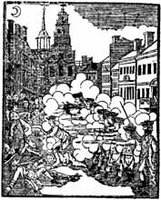Why Was Samuel Emmons Called to Testify?
According to defense counsel John Adams’s notes on the trial, Emmons’s testimony consisted entirely of:
I dont know any of the Prisoners. Nor anything.Prosecutor Robert Treat Paine wrote Emmons’s name in his notes and then crossed it out. The published record of the trial, prepared from John Hodgson’s shorthand notes, didn’t mention Emmons at all.
Hiller B. Zobel’s The Boston Massacre quotes Emmons as adding, “I was not in King Street. My brother was.” However, those words don’t appear in the many documents transcribed in The Legal Papers of John Adams, co-edited by Zobel. I don’t see an Emmons brother among the other witnesses.
So why was Samuel Emmons on the witness list?
I think the answer appears in the 1 Jan 1764 Boston News-Letter, where Emmons advertised:
TAR-WATER,Bishop George Berkeley and other authorities promoted water infused with tar as a medicine. Tar was also used in preparing ropes for use on ships, so a ropemaker might well have a supply around. Emmons’s advertisement put him in the part of central Boston where John Gray’s ropewalk stood.
MADE of Genuine Tar, to be sold by Samuel Emmons, Ropemaker, in Milk-Street, nigh the Foot of the Rope-Walks.
Thus, Emmons was almost certainly a witness to the big brawls between ropemakers and soldiers on 1 and 2 March, one of the events that raised tensions before the Massacre. Three of the soldiers on trial—Mathew Kilroy, William Warren, and John Carroll—were involved in those fights, as was victim Samuel Gray.
It looks like the prosecutors put Samuel Emmons on their list of possible witnesses as part of a plan to make the ropewalk fight a significant part of their case, just as it played a big role in the town’s Short Narrative of the Horrid Massacre. Later on 28 November they called ropemaker Nicholas Feriter to the stand; he described being involved in the fight and seeing Kilroy and Warren on the other side.
In a modern trial, those prosecutors would have learned more about what Samuel Emmons did and didn’t have to say before calling him to the stand. But Samuel Quincy and Paine didn’t have the time and personnel that modern prosecutors command. Who knows what the jury made of his remark?
More about Samuel Emmons appears in Robert Love’s Warnings, by Cornelia H. Dayton and Sharon V. Salinger. In 1753 he married Rachel Love, daughter of town employee Robert Love. They had their children baptized in the West Meetinghouse. In the 1780s Samuel became disabled because of “several touches of the Palsey,” and Rachel supported the family by keeping a small shop with a liquor license.






